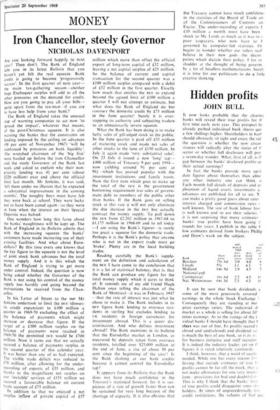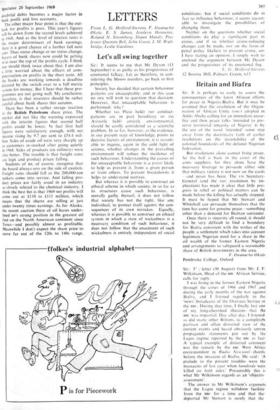Hidden profits
JOHN BULL
It now looks probable that the clearing banks will reveal their true profits for tt first time early next year. This prospect hr already pushed individual bank shares qui a few shillings higher. Shareholders in ban, should obviously sit tight and enjoy the rid the question is whether the new circus stances will radically alter the status of tI sector or whether full disclosure will pro a seven-day wonder. What, first of all, is 11 gap between the banks' disclosed profits ar their actual earnings?
In fact the banks provide more up-t' date figures about themselves than aline any other industry one can think o Each month full details of deposits and et ployment of liquid assets, investments a advances are published for all to see. Y can make a pretty good guess about rates interest charged and commission rates well known. The size of bank labour for( is well known and so are their salaries. ' it is not surprising that many estimates banks' true profits have been going t' rounds for years. I publish in the table f- low estimates derived from brokers Phillir and Drew's work on the subject.
teti- co,
mated mat.
1969 pri divi- divi- tar share dead dend it Bank price cover yield rat
Barclays 73s 6d 3.0 4.0 8 Lloyds 55s 3.1 4.3 7 Midland 64s 9d 2.9 4.5 7 National and Commercial 16s 6d 2.2 4.5 If
Nat. Westminster 64s 3d 2.3 4.3 It It can be seen that bank dividends a some of the most generously covered earnings in the whole Stock Exchange I Consequently they are standing at mo price earnings ratios. The industrial st market as a whole is selling for about fif' times earnings. As to the ratings of the i vidual banks I should have thought that I clays was out of line. Its profits record closed and undisclosed) and dividend rct is much the best of any bank, so is its rc. for business initiative and staff recruitn- It is indeed the industry leader, yet on tI figures it is rated relatively cautiously.
I think, however, that a word of cautie needed. While one has every reason fo- lieving that outside estimates of true 1— profits cannot be far off the mark. they c not make allowances for one very imoo-. item--provisions for bad and doubtful d This is why I think that the banks' first of true profits could disappoint some skin holders. At times of unprecedented!y tou credit restrictions, the volume of bad and doubtful debts becomes a major factor in bank profit and loss accounts.
The other major bear point is that the out- look for profits is poor. This year's figures will be down from the record levels achieved in 1968. And as the level of interest rates is the major determinant of bank earnings, there is a good chance of a further fall next year. Thus status change or no status change, buyers of bank shares now could be getting in at near the top of the profits cycle. I think one should think twice about that. I am also a little worried about the effects of corn-
P •
uterisation on profits in the short term. All the banks are working towards a deadline dictated by the switch over to a full metric system for money. But I hear that these pro- grammes are not going well. My conclusion, therefore, is that investors should be rather careful about bank shares this autumn.
There has been a rather savage reaction in the British Petroleum share price. The market did not like the warning expressed with the interim figures that second half profits could be lower. In fact first half figures were satisfactory enough, with net income rising by 9.7 per cent to £54.4 mil- lion. Sales of crude oil were very sharply up as customers re-stocked after going quietly in 1968. Sales of products (ex refinery) were also better. The trouble is that freight rates are high and product prices falling.
Students of BP, of course, recognise that the board always errs on the side of caution. Freight rates should fall as the 200,000-ton tankers come into service. And falling pro- duct prices are fairly usual in an industry so closely related to the chemical industry. I think the best bet is that 1969 net profits will come out at £110 to £111 million, which means that the shares are selling at just under twenty times earnings. As for Alaska, the recent auction there of oil leases under- lined BP'S strong position in the greatest oil find on the North American continent since Texas—and possibly almost as profitable. Meanwhile I don't expect the share price to move far out of the 120s to 140s range.
ffolkes's industrial alphabet
P is for Piecework









































 Previous page
Previous page